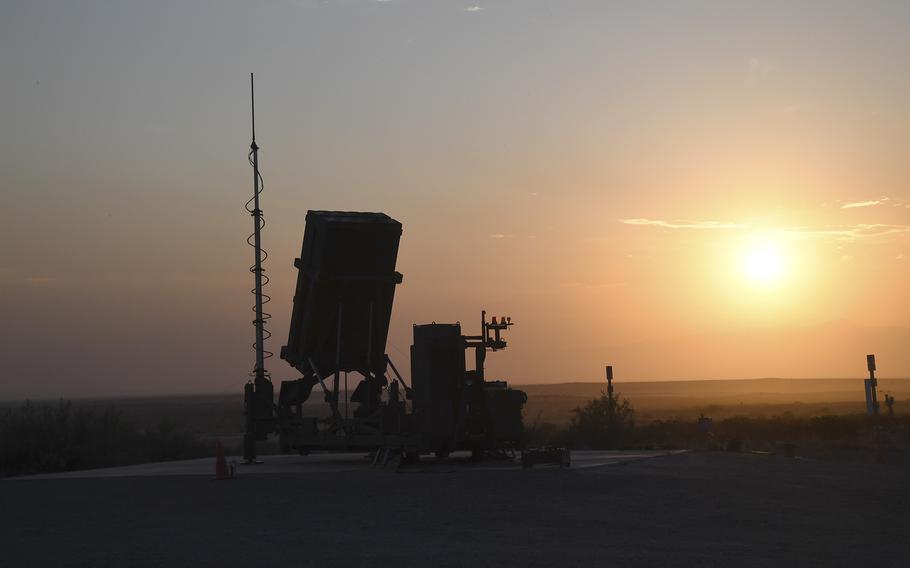
An Israeli Iron Dome Missile Defense system is tested during a live-fire exercise at White Sands Missile Range in New Mexico in August 2021. (David Huskey/U.S. Army)
(Tribune News Service) — In early November, a milestone in the history of human conflict appears to have been crossed.
Israel’s Aerial Defense System shot down a surface-to-surface missile near the Red Sea, an Israeli Defense Forces spokesperson said in a statement provided to McClatchy News.
This was likely the first-ever instance of state-to-state combat undertaken in space, Wendy Whitman Cobb, a professor of strategy and security studies at the U.S. Air Force School of Advanced Air and Space Studies, told McClatchy News.
The episode highlights the growing significance of space — specifically the area just above Earth’s atmosphere — as a theater of war, experts told McClatchy News. It also serves as a reminder that subtler forms of space warfare are occurring regularly, while slipping under the public’s radar.
What is space warfare?
Space warfare is an incredibly vague concept in search of a more precise definition, experts said.
It “is generally accepted that it includes ground-to-space warfare, such as attacking satellites from the Earth, as well as space-to-space warfare, such as satellites attacking satellites,” Martin Whelan, a senior vice president at the Aerospace Corporation, a federally funded research institute, told McClatchy News.
However, Brian Chow, an independent policy analyst, defined space warfare as involving assets already in space. By that definition, the recent Israeli missile interception would not count as space warfare as the missile was “not a space asset in orbit.”
Hostilities on the final frontier are not limited to active military warfare, though, Whitman Cobb said. They most often occur in more understated ways, such as through the use of cyber, jamming and laser technology.
Whether these actions legally constitute war is unclear as there are currently few laws governing space, which itself is not even clearly defined, Whitman Cobb said.
The United Nations’ Outer Space Treaty, ratified in 1967, is one of the only international agreements on the subject of space. It bans the use of weapons of mass destruction, including nuclear weapons, in outer space.
Still, countries regularly violate international treaties and can choose to break from them at any time, Paul Szymanski, president of the Space Strategy Center, a consulting group, told McClatchy News.
This largely toothless oversight, combined with the remoteness of space — a battlefield few can see — make it, for all intents and purposes, the wild west, experts said.
‘Cat and mouse game in space’
“There’s just a lot that is happening in space, sort of like in the 1960s and 70s you had Russian destroyers cutting off American destroyers, sometimes accidentally or not accidentally hitting them,” Szymanski said. “So this cat and mouse game is going on in space.”
Cyber and otherwise electronic interference in space constitutes a regular part of day-to-day operations for governments, Szymanski said.
For example, the U.S. Space Force, formed in 2019, acknowledged the use of counter communications systems, which use ground-based equipment that can temporarily disable adversaries’ satellites.
This kind of interference is difficult and time-consuming to trace, making it hard to know which parties, if any, are responsible, Szymanski said.
“You wake up one morning and your satellite stopped working,” Szymanski said. “Did it break just like my computer broke last week? Did solar flares do something? Did a micrometeor hit it? Let’s spend a few days, a few weeks trying to figure that out.”
Kinetic military action has also occasionally been undertaken in space, though, until now, it’s only taken the form of anti-satellite (ASAT) missile tests, Whitman Cobb said.
“Four states have actually conducted ASAT tests to this point: the Soviet Union — now Russia — the United States, China and India,” Whitman Cobb said. “All of those ASAT tests have been the countries taking out a satellite of their own, not targeted against another state.”
In 2022, the U.S. became the first nation to commit to banning these tests, which create long-lasting debris fields, according to the White House.
Serious ramifications
Space assets support modern life as we know it, and attacks on them could have significant ramifications for the military, the economy and space exploration, experts said.
One such possible scenario is “a ’Space Pearl Harbor’ as a shock-and-awe precursor to China’s military campaign to seize Taiwan,” Chow said.
The Chinese military could launch a large-scale preemptive attack on U.S. satellites, potentially deterring an American military response, Chow wrote in a 2015 Defense News article.
The Chinese also possess fractional orbital bombardment systems (FOBS), which can deliver warheads from low Earth orbit, Szymanski said.
This technology poses a grave threat to the U.S. military, which is primarily a sea power, Szymanski said. If China targeted American aircraft carriers around the globe, it could eliminate the U.S. as a world power “in one evening.”
The Chinese development of FOBS, first announced in 2019, represents “yet another step in a pointless, costly, and dangerous arms race,” according to a report from the Carnegie Endowment for International Peace.
Disruption or destruction of satellites — more than 6,000 of which orbit the Earth — could also have detrimental effects on the world economy, Whitman Cobb said.
“A lot of our global economy is predicated on space-based assets,” Whitman Cobb said. “We have seen instances in the past couple of decades where one satellite having a tiny malfunction has all of these trickle down effects.”
Additionally, destroyed satellites could have serious implications for the future use of space, Whelan said.
“If an adversary purposely destroys a satellite, even one of its own, it would result in a debris field that could severely limit or close off human use of specific orbits,” Whelan said.
“There’s a lot of things that could go really bad, really quick,” Whitman Cobb said. “So I really hope we don’t get to that point.”
©2023 Miami Herald.
Visit miamiherald.com.
Distributed by Tribune Content Agency, LLC.